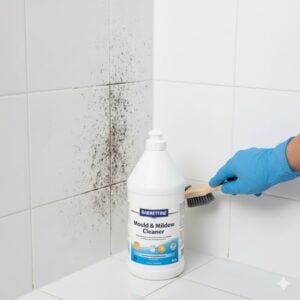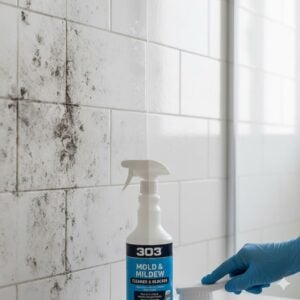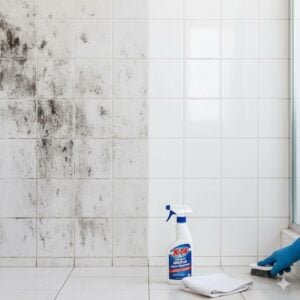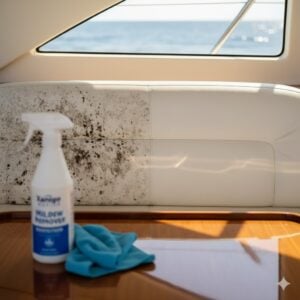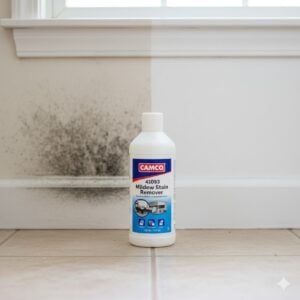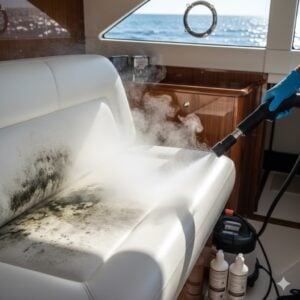Mold damage in homes can be subtle yet pervasive, posing significant health risks and structural challenges. Recognizing the early signs of mold is crucial for timely intervention and preventing its spread. In our comprehensive guide, “8 Critical Signs of Mold Damage and How to Act Fast,” we aim to empower homeowners with the knowledge to identify mold issues promptly and take decisive action. Understanding these signs is key to maintaining a healthy living environment and safeguarding your home’s integrity. Let’s explore these critical indicators and learn how to effectively respond to protect your home and health from the impacts of mold.
[lwptoc]
Table of Contents
Toggle1. Visible Mold Growth
One of the most unmistakable signs of a mold problem in your home is visible mold growth. Unlike some other indicators, which might require more careful observation or specialized detection methods, visible mold is hard to miss. It often appears as a patch or a collection of spots, which can vary in color – from black, green, or gray to white and even shades of blue. These patches may grow over time, expanding across walls, ceilings, or other surfaces.
It’s important to understand that visible mold growth is not just an aesthetic issue; it’s a clear signal of underlying moisture problems in your home. Mold thrives in damp environments, so its presence often points to issues like leaks, high humidity, or condensation problems. The areas most susceptible to visible mold growth include bathrooms, kitchens, basements, and around windows or pipes where moisture can accumulate.
When you spot visible mold, it’s crucial to act quickly. While small patches of mold can sometimes be cleaned by homeowners using proper safety gear and cleaning solutions, extensive mold growth requires professional assessment and remediation. This is because mold can penetrate beneath the surface, and superficial cleaning might not address the root of the problem.
Moreover, disturbing mold patches without proper precautions can release spores into the air, exacerbating the issue and potentially leading to health problems for the occupants. Seeking assistance from professionals, as discussed in 5 Essential Steps for Complete Mold Remediation Success, ensures safe and effective removal and helps prevent future growth. Remember, visible mold growth is a sign that should never be ignored in any home.
2. Musty Odors
Musty odors in your home are a significant indicator of mold presence, often signaling mold growth in areas that are not immediately visible. This distinct smell is not just unpleasant; it’s a warning sign of hidden mold colonies possibly thriving behind walls, under floors, or in other concealed spaces. Mold emits a characteristic earthy, damp scent, similar to what you might smell in old books or damp, shaded outdoor areas.
Identifying musty odors is especially important because mold can grow in places that are not readily accessible or easily seen. Common hidden spots include behind wallpaper, inside HVAC systems, under carpets, or in attic and basement corners. These areas might have moisture problems due to leaks, condensation, or poor ventilation, creating ideal conditions for mold to flourish unnoticed.
When you detect a musty odor, it’s crucial to investigate its source. Ignoring it can lead to the mold spreading and potentially causing structural damage and health problems. Chronic exposure to mold can lead to respiratory issues, allergies, and other health concerns, especially for those with preexisting conditions.
Addressing musty odors often requires more than just airing out the room or using deodorizers. It involves identifying the moisture source feeding the mold and resolving it. In many cases, professional help from mold remediation experts is needed. Companies like us have the expertise and equipment to detect hidden mold, assess the extent of the infestation, and recommend appropriate remediation steps, as outlined in 3 Unbeatable Mold Remediation Services for Peace of Mind.
In conclusion, musty odors in your home should always be taken seriously as they are often the first clue to hidden mold problems. Prompt investigation and action are key to preventing the spread and safeguarding your home’s and family’s health.
3. Water Damage and Stains
Water damage and stains on ceilings, walls, or floors are critical indicators of potential mold issues in your home. These signs often manifest as discolored patches, peeling paint, or warped surfaces and usually indicate prolonged exposure to moisture – a primary catalyst for mold growth.
The presence of water stains or damage is usually a consequence of issues such as leaking pipes, roof damage, or flooding. In areas with high humidity, condensation can also contribute to these problems. The danger with water damage is that it not only affects the aesthetic appeal of your home but also weakens structural integrity and creates an environment conducive to mold.
It’s essential to address any signs of water damage promptly. Simply painting over a stain does not solve the underlying moisture problem and can lead to more significant mold issues. The first step in addressing this problem is identifying the source of the moisture. This might involve checking for leaks in the plumbing system, inspecting roofs and windows for integrity, or ensuring proper ventilation to reduce indoor humidity.
Once the source of the moisture is found and rectified, it’s crucial to dry out the affected area thoroughly. Depending on the extent of the damage, this process might require professional assistance. Mold remediation experts can assess the damage, advise on the best course of action, and provide services to repair and restore affected areas, as detailed in 5 Essential Steps for Complete Mold Remediation Success.
In summary, water damage and stains are more than just cosmetic issues. They are often signs of deeper problems that, if not addressed, can lead to mold growth and other structural challenges in your home. Prompt attention and remediation are key to maintaining a healthy, mold-free living environment.
4. Peeling Wallpaper or Paint
Peeling wallpaper or paint is a telltale sign of mold damage that homeowners should never overlook. Often, this issue is more than just a cosmetic flaw; it indicates an underlying moisture problem, which creates an ideal breeding ground for mold. When wallpaper or paint begins to peel, bubble, or crack, it’s often because moisture has seeped into the wall materials, breaking down adhesives and paint bonds.
The presence of moisture behind walls can go unnoticed for a long time, allowing mold to grow and spread unseen. This hidden mold can eventually cause significant damage to the structure and even pose health risks to the inhabitants. The areas around bathrooms, kitchens, and basements are particularly susceptible due to higher humidity levels and potential plumbing leaks.
Addressing peeling wallpaper or paint involves more than just reapplying a fresh coat. It’s crucial to investigate and resolve the source of the moisture first. This could involve repairing leaks, improving ventilation, or using dehumidifiers to reduce indoor humidity levels.
Experts in mold remediation can provide a thorough assessment and recommend the most effective course of action. They possess the tools and knowledge to identify whether the peeling is indeed due to mold and can advise on both the remediation of the mold and the necessary repairs to prevent recurrence. For insights into professional mold removal techniques, The 6 Most Effective Mold Removal Techniques for a Healthier Home offers valuable information.
In summary, peeling wallpaper or paint should always be investigated as a potential sign of mold damage. Taking early and appropriate action can prevent further damage and maintain the integrity and health of your home.
5. Health Symptoms in Occupants
When considering the impact of mold in a home, one of the most telling signs is the health of those living in it. Mold can have a range of effects on health, and noticing a pattern of symptoms among household members can be a crucial indicator of its presence.
Mold exposure, particularly over prolonged periods, can lead to various health issues. Common symptoms include respiratory problems, such as coughing, wheezing, or difficulty breathing, especially in those with asthma or allergies. Other signs can include skin irritation, sore throat, itchy eyes, and even frequent headaches or fatigue. These symptoms are particularly concerning if they seem to lessen when away from home, suggesting an environmental cause within the residence.
It’s important to note that while these symptoms can be indicative of mold exposure, they can also be caused by other factors. However, if you’re experiencing these health issues alongside other signs of mold in your home, it’s a strong hint that mold could be contributing to these ailments.
If mold-related health symptoms are suspected, it’s advisable to seek both medical advice and a professional home mold inspection. While a healthcare provider can address the health concerns, a mold expert can assess your home for mold, identify the source, and recommend appropriate remediation steps. Remember, addressing mold isn’t just about preserving your home’s integrity—it’s also about protecting the health and well-being of its occupants. Regularly checking for mold signs, as discussed in 7 Pillars of Mold Control: Protect Your Home Effectively, can help mitigate these risks.
6. Excessive Humidity and Condensation
Excessive humidity and condensation in your home are clear signals of a potential mold problem. High levels of indoor moisture create the perfect breeding ground for mold, and noticing this issue should prompt immediate action. Condensation on windows, walls, or pipes, especially if it’s a recurring problem, indicates that the air inside your home holds too much moisture.
Managing indoor humidity is crucial in mold prevention. Ideally, indoor humidity levels should be kept between 30-50%. You can monitor these levels using a simple hygrometer. Persistent high humidity can lead to condensation, which, over time, dampens surfaces enough for mold to take hold. This is particularly common during colder months when warm indoor air condenses on cooler surfaces, like windows or external walls.
In addition to visible condensation, other signs of excessive humidity include a general damp feeling in the air, frequent fogging of windows, and a musty odor – a telltale sign of mold. These indicators suggest that the indoor air quality needs improvement.
To combat this, ensure adequate ventilation throughout your home. This might involve using exhaust fans in high-moisture areas like kitchens and bathrooms, opening windows when weather permits, or using dehumidifiers in particularly damp spaces. Improving your home’s ventilation can significantly reduce moisture levels, thereby hindering mold growth.
It’s also wise to inspect your home for any leaks or water intrusion, as these can contribute to high humidity levels. Regular maintenance, as suggested in articles like 5 Home Mold Removal Tips That Actually Work, can help prevent these issues and keep your home dry and mold-free. Remember, controlling indoor humidity is a key step in maintaining a healthy, mold-free environment.
7. Warped or Bulging Walls
Warped or bulging walls in your home are often a red flag for hidden mold problems. These structural deformities usually occur when the materials that make up the walls – such as wood or drywall – absorb excessive moisture. Over time, this moisture can cause the material to swell, distort, or warp, leading to noticeable changes in the wall’s appearance.
This warping or bulging is more than just a structural concern; it’s a sign that the conditions within the walls are ripe for mold growth. Mold thrives in moist, enclosed spaces, and a warped wall could indicate that mold is growing unseen within. Such a scenario is particularly likely if the warping is accompanied by a musty smell, another common sign of mold.
Addressing this issue involves more than just cosmetic repairs. It’s crucial to identify and rectify the source of the moisture causing the warping. This might mean fixing leaks, improving insulation, or enhancing ventilation in the affected area. Once the moisture issue is resolved, the affected sections of the wall will often need to be replaced to eliminate any existing mold and prevent future growth.
Professional assessment can be invaluable in such situations. Experts can determine the extent of the damage and the likelihood of hidden mold, advising on the best course of action. For insights into handling such structural issues, resources like Top 7 Mold Restoration Techniques to Reclaim Your Home can provide useful guidance.
In summary, if you notice warping or bulging in your home’s walls, it’s important to take it seriously as a potential sign of mold. Prompt action and professional advice can ensure that your home remains safe, structurally sound, and mold-free.
8. Rusty Pipes and HVAC Issues
Rusty pipes and issues with your Heating, Ventilation, and Air Conditioning (HVAC) system can be subtle yet significant indicators of mold problems in your home. These issues are often symptomatic of excess moisture and humidity, which create ideal conditions for mold growth.
Rust on pipes, especially those running through basements or crawl spaces, can signal chronic dampness or water leakage. Since these areas are typically out of sight, mold can develop and spread unnoticed for long periods. It’s essential to regularly inspect these spaces and address any signs of rust or leakage promptly. Neglecting these maintenance checks can lead to more severe mold infestations.
Similarly, HVAC systems can be a hotspot for mold growth. Poorly maintained or malfunctioning HVAC systems can lead to moisture buildup, particularly in ductwork and drain pans. This problem is often compounded if the system is circulating spores throughout the house, potentially affecting the entire home’s air quality.
Proactive maintenance is crucial in preventing these issues. Regular HVAC servicing, including cleaning of air ducts and changing filters, can significantly reduce the risk of mold. Also, ensuring that pipes are well insulated and free from leaks can prevent rust and moisture accumulation.
In cases where mold is suspected in the HVAC system or associated with plumbing issues, consulting with a mold remediation expert is advisable. They can assess the situation and provide solutions to not only remove the mold but also prevent its recurrence. Articles like Mold Cleaning Services: 7 Elite Mold Cleaning Services to Restore Your Home’s Comfort offer insights into professional mold cleaning services that can help address these issues effectively.
In conclusion, paying attention to the condition of your pipes and HVAC system can help catch early signs of mold. Regular maintenance and swift action upon noticing issues like rust or HVAC malfunctions are key steps in maintaining a mold-free home.
Why Choose Bio-On for Mold Damage Remediation
Bio-On is a top choice for tackling mold damage, offering unmatched expertise and comprehensive solutions. Their team specializes in identifying and addressing the full scope of mold damage, ensuring that both visible and underlying issues are resolved. Bio-On employs the latest technology for effective mold remediation, including advanced moisture detection and HEPA filtration systems, to thoroughly eradicate mold.
Central to Bio-On’s approach is a commitment to customer safety and satisfaction. They prioritize non-toxic, safe remediation methods to protect homeowners’ health during and after the mold removal process. Bio-On also emphasizes educating clients about preventive measures to safeguard against future mold issues.
With a proven track record in successfully handling mold damage across various home settings, Bio-On stands out as a reliable, skilled, and customer-focused service provider. Their holistic approach not only addresses immediate mold concerns but also contributes to the long-term health and comfort of your home, making them an ideal partner in mold damage remediation.
Conclusion
In conclusion, recognizing and addressing mold damage promptly is essential for maintaining a healthy home environment. From visible mold growth and musty odors to peeling wallpaper and excessive humidity, being aware of these critical signs can prevent further damage and safeguard your family’s health. Effective mold remediation goes beyond surface cleaning, requiring a comprehensive approach that tackles both the symptoms and root causes of mold. By understanding these key indicators and taking swift action, homeowners can effectively manage mold damage, ensuring their living spaces remain safe, structurally sound, and free from harmful mold.








